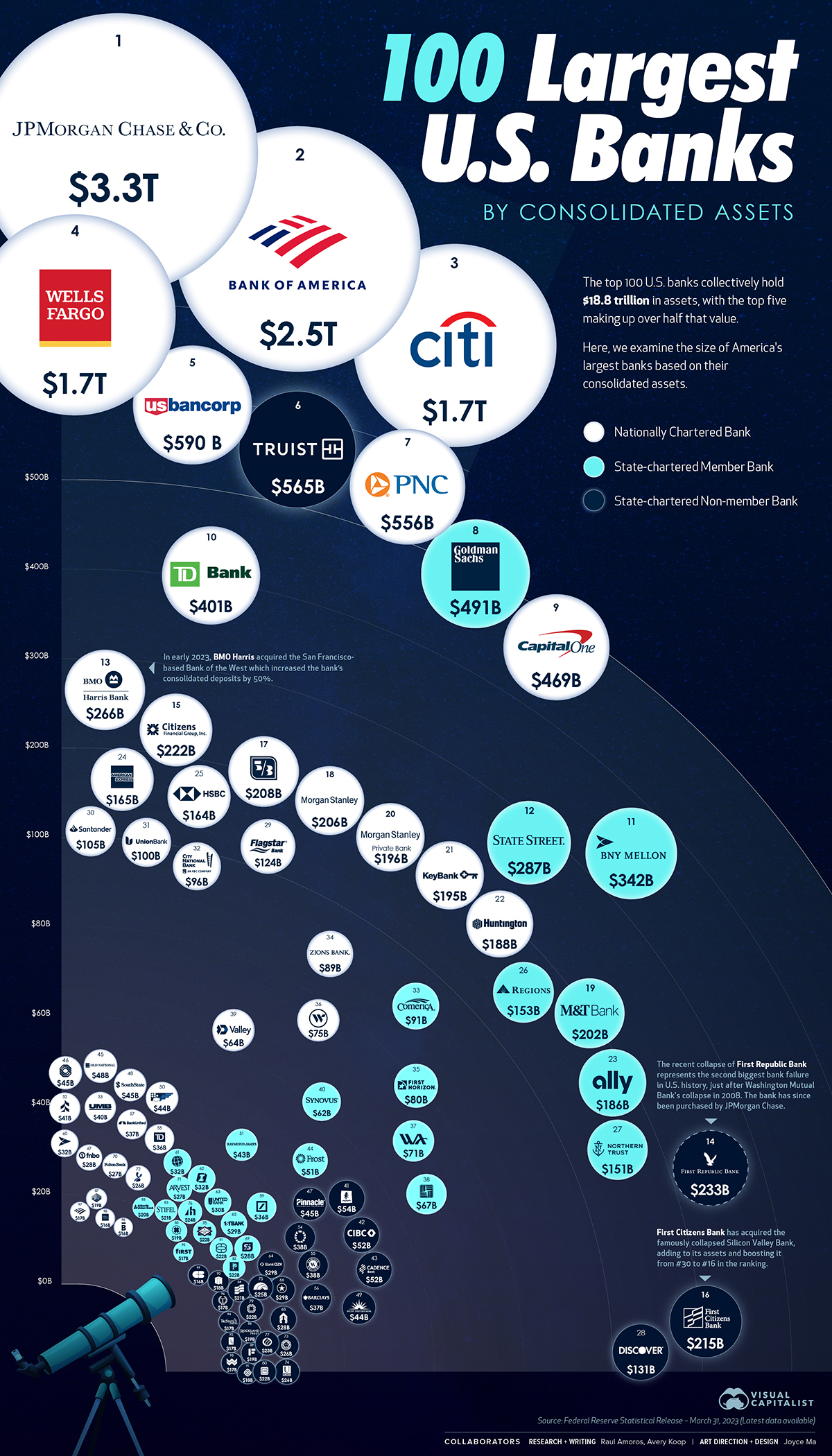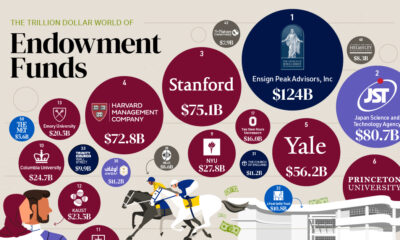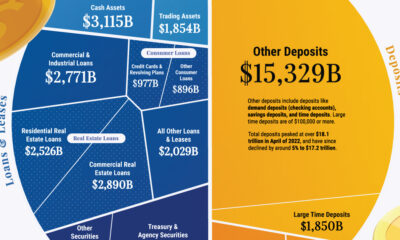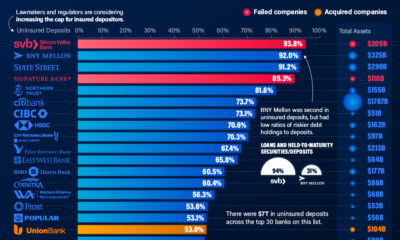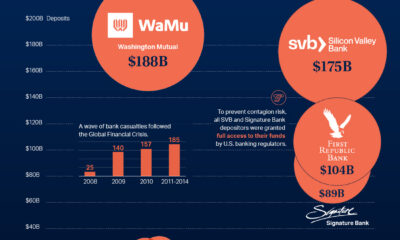Finance
Visualized: The 100 Largest U.S. Banks by Consolidated Assets
View the high-resolution version of this infographic.
The 100 Largest U.S. Banks by Consolidated Assets
The largest 100 banks in the U.S. hold a combined $18.8 trillion in consolidated assets, but recent collapses of medium-sized banks like Silicon Valley Bank and First Republic have caused worries throughout the banking world.
This visual using data from the Federal Reserve ranks the country’s 100 largest banks by the size of their consolidated assets.
The Top 100 Banks
America’s biggest bank is JP Morgan Chase with over $3.3 trillion in assets, with Bank of America trailing behind in second place with $2.5 trillion. Here’s a closer look at the numbers:
| Rank | Bank / Holding Co Name | Consolidated Assets ($ Millions) |
|---|---|---|
| #1 | JP Morgan Chase Bank | $3,267,963 |
| #2 | Bank of America | $2,518,290 |
| #3 | Citibank | $1,721,547 |
| #4 | Wells Fargo | $1,687,507 |
| #5 | US Bancorp | $590,460 |
| #6 | Truist Bank | $564,837 |
| #7 | PNC Bank | $556,314 |
| #8 | Goldman Sachs | $490,799 |
| #9 | Capital One | $469,432 |
| #10 | TD Bank | $401,245 |
| #11 | Bank of NY Mellon | $341,455 |
| #12 | State Street | $287,069 |
| #13 | BMO Harris Bank | $265,446 |
| #14 | First Republic | $232,944 |
| #15 | Citizens Bank | $221,955 |
| #16 | First Citizens Bank | $214,599 |
| #17 | Fifth Third Bank | $207,586 |
| #18 | Morgan Stanely | $205,845 |
| #19 | Manufacturers and Traders Bank | $202,363 |
| #20 | Morgan Stanley Private Bank | $195,667 |
| #21 | Keybank | $195,191 |
| #22 | Huntington National Bank | $188,441 |
| #23 | Ally Bank | $186,383 |
| #24 | American Express | $165,450 |
| #25 | HSBC Bank USA | $164,492 |
| #26 | Regions Bank | $153,125 |
| #27 | Northern Trust | $150,573 |
| #28 | Discover Bank | $130,703 |
| #29 | Flagstar Bank | $123,633 |
| #30 | Santander Bank | $105,314 |
| #31 | MUFG Union Bank | $99,964 |
| #32 | City National Bank | $96,370 |
| #33 | Comerica Bank | $91,259 |
| #34 | Zions Bank | $88,574 |
| #35 | First Horizon Bank | $80,465 |
| #36 | Webster Bank | $74,793 |
| #37 | Western Alliance Bank | $70,986 |
| #38 | East West Bank | $67,219 |
| #39 | Valley National Bank | $64,314 |
| #40 | Synovus Bank | $61,726 |
| #41 | Umqua Bank | $53,986 |
| #42 | CIBC | $52,146 |
| #43 | Cadence Bank | $51,693 |
| #44 | Frost Bank | $51,286 |
| #45 | Old National Bank | $47,554 |
| #46 | BOK Financial | $45,269 |
| #47 | Pinnacle Bank | $44,988 |
| #48 | Southstate Bank | $44,903 |
| #49 | Pacific Western Bank | $44,255 |
| #50 | First National Bank of Pennsylvania | $44,132 |
| #51 | Raymond James Bank | $43,359 |
| #52 | Associated Bank | $40,653 |
| #53 | UMB Bank | $40,354 |
| #54 | Prosperity Bank | $37,829 |
| #55 | Hancock Whitney Bank | $37,525 |
| #56 | Barclays Bank | $37,352 |
| #57 | United Bank | $37,095 |
| #58 | TD Bank | $36,460 |
| #59 | Deutsche Bank | $36,103 |
| #60 | BNY Mellon | $31,945 |
| #61 | Commerce Bank | $31,853 |
| #62 | First Interest Bank | $31,565 |
| #63 | United Bank | $30,108 |
| #64 | Bank OZK | $28,971 |
| #65 | Firstbank | $28,764 |
| #66 | Texas Capital | $28,592 |
| #67 | First National Bank of Omaha | $28,393 |
| #68 | Glacier Bank | $27,785 |
| #69 | Simmons Bank | $27,538 |
| #70 | Fulton Bank | $26,996 |
| #71 | Arvest Bank | $26,946 |
| #72 | City National Bank of Florida | $26,204 |
| #73 | Ameris Bank | $25,991 |
| #74 | United Community Bank | $25,815 |
| #75 | First Hawaiian Bank | $24,883 |
| #76 | Bank of Hawaii | $23,904 |
| #77 | Eastern Bank | $22,702 |
| #78 | Centennial Bank | $22,452 |
| #79 | Washington Federal Bank | $22,320 |
| #80 | Cathay Bank | $22,016 |
| #81 | Customers Bank | $21,768 |
| #82 | Pacific Premier Bank | $21,362 |
| #83 | Stifel Banking and Lending | $20,969 |
| #84 | Bank of Hope | $20,564 |
| #85 | Atlantic Union Bank | $19,990 |
| #86 | Rockland Trust | $19,445 |
| #87 | Trustmark National Bank | $18,875 |
| #88 | Central Bancompany | $18,850 |
| #89 | DBA Independent Financial | $18,793 |
| #90 | First Merchants Bank | $18,165 |
| #91 | Mechanics Bank | $17,946 |
| #92 | Renasant Bank | $17,479 |
| #93 | Wesbanco | $17,237 |
| #94 | Tristate Capital Bank | $17,050 |
| #95 | First Financial Bank | $16,857 |
| #96 | Townebank | $16,730 |
| #97 | Bank of America | $16,550 |
| #98 | Wells Fargo | $16,473 |
| #99 | Citizens Bank | $16,271 |
| #100 | Bremer Bank | $15,763 |
The first and second place banks combined account for around 30% of the consolidated assets on this list. On the flip side, the smallest bank is Bremer Bank at $15.8 billion in consolidated assets. While this seems small in the context of this list, there are actually thousands of even smaller commercial financial institutions in the country.
Many banks have seen significant changes to their ranking since the last Fed data at the end of 2022. BMO Harris moved up 10 spots, going from $177 billion in consolidated assets to $265 billion—an increase of 50%. In February, the bank acquired the San Francisco-based Bank of the West (which previously ranked 34th on this list).
First Citizens also saw its rank improve, going from 30th to 16th, thanks to the acquisition of the remnants of Silicon Valley Bank.
In May 2023, a planned merger between First Horizon and TD Bank was mutually terminated. The merger, had it gone ahead, would have seen TD Bank surpass the size of Capital One.
Banking Heavyweights
Typically, big banks are less of a risk for borrowers in terms of their liquidity, holding huge sums in diversified assets, whereas smaller and more regional American banks have a narrower margin for error. However, many other factors beyond size play into risk, like an institution’s loan portfolio or management style.
Volatility in the banking sector is expected to have implications on the wider economy. For example, bank lending capacity is expected to decrease by 1% this year, a shift which the IMF expects will take almost half a percentage point off the U.S.’ overall GDP.
The largest banks have set aside billions in anticipation of bad loans as a result of pressure from rising interest rates. JP Morgan Chase currently has $2.3 billion in provisions/reserves built. Here’s a look at some of the current reserves that banks have set aside based on most recent data:
| Bank | Reserves Built / Reserves Released | As of |
|---|---|---|
| JP Morgan Chase | $2.3 billion | Q1 2023 |
| Wells Fargo | $1.2 billion | Q1 2023 |
| Goldman Sachs | $972 million | Q4 2022 |
| Citigroup | $241 million | Q1 2023 |
| Morgan Stanley | $234 million | Q1 2023 |
| Bank of America | $124 million | Q1 2023 |
Bank Volatility
Small and medium sized banks (<$250 billion in assets) play an important role in the economy. Collectively, these banks are responsible for 45% of consumer lending and 80% of commercial real estate lending.
However, lending by these banks has been tightening up, given the current economic conditions and fears around bank collapses.
Overall, continued turmoil in the banking sector would likely reduce profitability for banks and ultimately slow economic growth.
Finance
De-Dollarization: Countries Seeking Alternatives to the U.S. Dollar
The U.S. dollar is the dominant currency in the global financial system, but some countries are following the trend of de-dollarization.
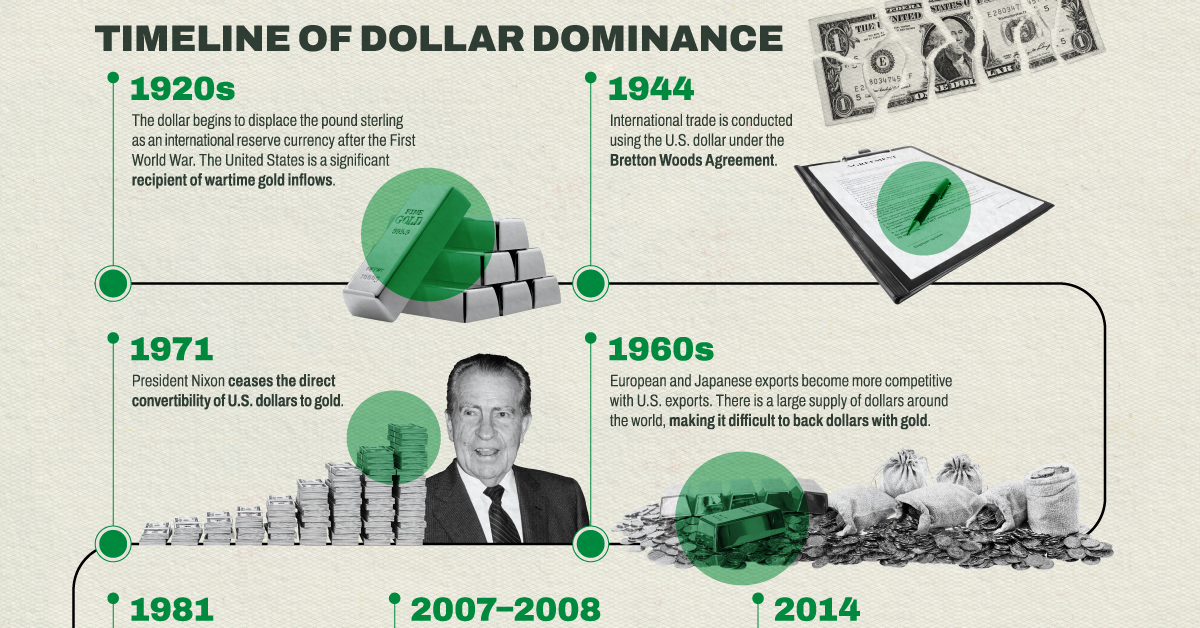
De-Dollarization: Countries Seeking Alternatives to U.S. Dollar
This was originally posted on Elements. Sign up to the free mailing list to get beautiful visualizations on natural resource megatrends in your email every week.
The U.S. dollar has dominated global trade and capital flows over many decades.
However, many nations are looking for alternatives to the greenback to reduce their dependence on the United States.
This graphic catalogs the rise of the U.S. dollar as the dominant international reserve currency, and the recent efforts by various nations to de-dollarize and reduce their dependence on the U.S. financial system.
The Dollar Dominance
The United States became, almost overnight, the leading financial power after World War I. The country entered the war only in 1917 and emerged far stronger than its European counterparts.
As a result, the dollar began to displace the pound sterling as the international reserve currency and the U.S. also became a significant recipient of wartime gold inflows.
The dollar then gained a greater role in 1944, when 44 countries signed the Bretton Woods Agreement, creating a collective international currency exchange regime pegged to the U.S. dollar which was, in turn, pegged to the price of gold.
By the late 1960s, European and Japanese exports became more competitive with U.S. exports. There was a large supply of dollars around the world, making it difficult to back dollars with gold. President Nixon ceased the direct convertibility of U.S. dollars to gold in 1971. This ended both the gold standard and the limit on the amount of currency that could be printed.
Although it has remained the international reserve currency, the U.S. dollar has increasingly lost its purchasing power since then.
Russia and China’s Steps Towards De-Dollarization
Concerned about America’s dominance over the global financial system and the country’s ability to ‘weaponize’ it, other nations have been testing alternatives to reduce the dollar’s hegemony.
As the United States and other Western nations imposed economic sanctions against Russia in response to its invasion of Ukraine, Moscow and the Chinese government have been teaming up to reduce reliance on the dollar and to establish cooperation between their financial systems.
Since the invasion in 2022, the ruble-yuan trade has increased eighty-fold. Russia and Iran are also working together to launch a cryptocurrency backed by gold, according to Russian news agency Vedmosti.
In addition, central banks (especially Russia’s and China’s) have bought gold at the fastest pace since 1967 as countries move to diversify their reserves away from the dollar.
How Other Countries are Reducing Dollar Dependence
De-dollarization it’s a theme in other parts of the world:
- In recent months, Brazil and Argentina have discussed the creation of a common currency for the two largest economies in South America.
- In a conference in Singapore in January, multiple former Southeast Asian officials spoke about de-dollarization efforts underway.
- The UAE and India are in talks to use rupees to trade non-oil commodities in a shift away from the dollar, according to Reuters.
- For the first time in 48 years, Saudi Arabia said that the oil-rich nation is open to trading in currencies besides the U.S. dollar.
Despite these movements, few expect to see the end of the dollar’s global sovereign status anytime soon. Currently, central banks still hold about 60% of their foreign exchange reserves in dollars.
-
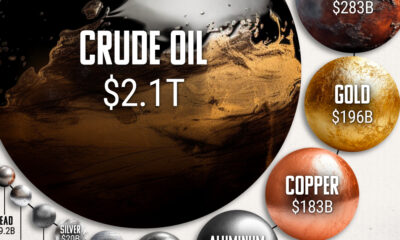
 Markets3 weeks ago
Markets3 weeks agoHow Big is the Market for Crude Oil?
-
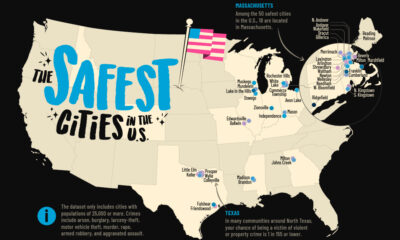
 Maps7 days ago
Maps7 days agoMapped: The Safest Cities in the U.S.
-

 Markets2 weeks ago
Markets2 weeks agoRanked: The Most Profitable U.S. Companies, by Sector
-
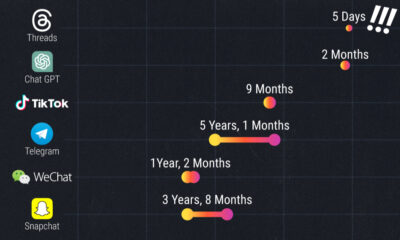
 apps5 days ago
apps5 days agoHow Long it Took for Popular Apps to Reach 100 Million Users
-
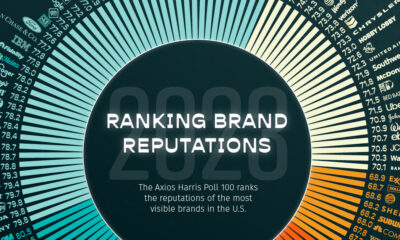
 Brands2 weeks ago
Brands2 weeks agoBrand Reputations: Ranking the Best and Worst in 2023
-
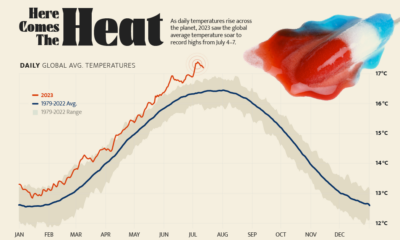
 Green5 days ago
Green5 days agoHotter Than Ever: 2023 Sets New Global Temperature Records
-
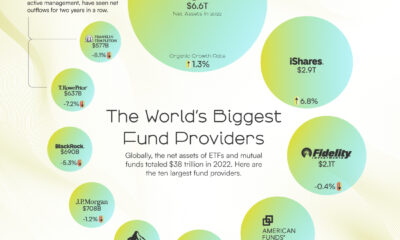
 Markets4 weeks ago
Markets4 weeks agoThe World’s Biggest Mutual Fund and ETF Providers
-
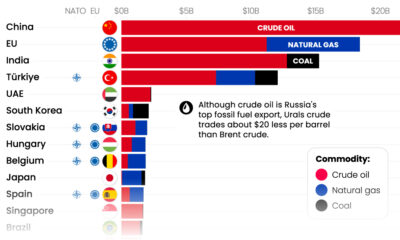
 Energy2 weeks ago
Energy2 weeks agoWho’s Still Buying Russian Fossil Fuels in 2023?

